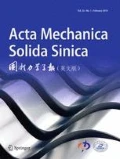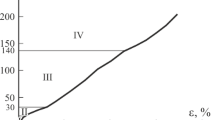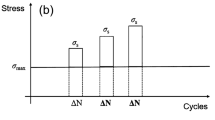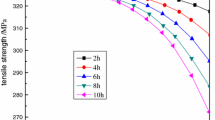Abstract
Based on the thermodynamic theory, an orthotropic damage constitutive model was developed to describe the nonlinear mechanical behavior of C/SiC composites. The different nonlinear kinematic and isotropic hardening functions were adopted to describe accurately the damage evolution processes. The damage variables were defined with the damaged modulus and the initial undamaged modulus on energy equivalence principle. The initial orthotropy and damage coupling were presented in the damage yield function. Tensile and in-plane shear loading and unloading tests were performed, and a good agreement between the model and the experimental results was achieved.
Similar content being viewed by others
References
Besmann, T.M., Sheldon, B.W., Lowden, R.A. and Stinton, D.R., Vapor-phase fabrication and properties of continuous-filament ceramic composites. Science, 1991, 253: 1104–1109.
Ishikawa, T., Kajii, S., Matsanaga, K., Hogani, T., Kohtoku, Y. and Nagasawa, T., A tough, thermally conductive silicon carbide composite with high strength up to 1600 °C in air. Science, 1998, 282: 1295–1297.
Evans, A.G. and Marshall, D.B., Overview no.85 the mechanical behavior of ceramic matrix composites. Acta Metallurgica, 1989, 37: 2567–2583.
Warren, R., Ceramic Matrix Composites. Chapman & Hall: London, 1992.
Kachanov, L.M., Time of the rupture process under creep conditions. Izv. Akad. Nauk., S.R.S., Odt. Tekh. Nauk 8, 1958: 26–31.
Resende, L., A damage mechanics constitutive theory for the inelastic behavior of concrete. Computer Methods in Applied Mechanics and Engineering, 1987, 60: 57–93.
Krajcinovic, D., Damage mechanics. Mechanics of Materials, 1989, 8: 117–197.
Faria, R, Oliver, J. and Cervera, M., A strain-based plastic viscous-damage model for massive concrete structures. International Journal of Solids Structures, 1998, 35: 1533–1558.
Ladevèze, P., Gasser, A. and Allix, O., Damage mechanics modeling for ceramic composites. Journal of Engineering Materials and Technology, 1994, 116: 331–336.
Chaboche, J.L., Lesne, P.M. and Maire, J.F., Macroscopic modeling and damage processes in CMCs. Ceramic Transactions, 1995, 57: 65–75.
Burr, A., Hild, F. and Leckie, F.A., Continuum description of damage in ceramic-matrix composites. European Journal of Mechanics A-Solids, 1997, 16: 53–78.
Raghavan, P. and Ghosh, S., A continuum damage mechanics model for unidirectional composites undergoing interfacial debonding. Mechanics of Materials, 2005, 37: 955–979.
Dinkier, D, Fink, A. and Kröplin, B., Constitutive laws for fiber reinforced ceramics. 1993, AIAA–93–5038.
Maire, J.F. and Lesne, P.M., A damage model for ceramic matrix composites. Aerospace Science and Technology, 1997, 4: 259–266.
Camus, G., Modeling of the mechanical behavior and damage processes of fibrous ceramic matrix composites: application to a 2-D SiC/SiC. International Journal of Solids and Structures, 2000, 37: 919–942.
Chaboche, J.L. and Maire, J.F., A new micromechanics based CDM model and its application to CMC’s. Aerospace Science and Technology, 2002, 6: 131–145.
Marcin, L., Maire, J.F. and Carrère, N., Development of a macroscopic damage model for woven ceramic matrix composites. International Journal of Damage Mechanics, 2011, 20: 939–958.
Nemat-Nasser, S., On finite plastic flow of crystalline solids and geomaterials. International Journal of Applied Mechanics, 1983, 50: 1114–1126.
Lubliner, J., Plasticity Theory. Macmillan Publishing Company: New York, 1990.
Baste, S., Inelastic behavior of ceramic-matrix composites. Composites Science and Technology, 2001, 61: 2285–2297.
Voyiadjis, G.Z. and Park, T., Kinematics description of damage for finite strain plasticity. International Journal of Engineering Science, 1999, 37: 803–830.
Kachanov, L.M., Introduction to Continuum Damage Mechanics. Martinus Nijhoff Publishers: The Netherlands, 1986.
Lemaitre, J. and Chaboche, J.L., Mechanics of Solid Materials. Cambridge University Press: London, 1990.
Rabotnov, Y.N., Creep Rupture. Proceedings of the 12th International Congress on Applied Mechanics. Stanford-Springer: In, 1968, 342–349.
Krajcinovic, D. and Fonseka, G.U., The continuous damage theory of brittle materials: Parts I and II. Journal of Applied Mechanics. 1981, 48: 809–824.
Cordebois, J.P. and Sidoroff, F., Damage Induced Elastic Anisotropy. Colloque Euromech 115: VillarddeLans, 1979.
Murakami, S., Notion of continuum damage mechanics and its application to anisotropic creep damage theory. Journal of Engineering Materials and Technology, 1983, 105: 99–105.
Chaboche, J.L., Le concept de contrainte effective appliquéà l’élasticité et à la viscoplasticité en présence d’un endommagement anisotrope. Col. Euromech 115, Grenoble, CNRS, 1979.
Ju, J.W., On energy-based coupled elastoplastic damage theories: constitutive modeling and computational aspects. International Journal of Solids and Structures, 1989, 25: 803–833.
Sidoroff, F., Description of anisotropic damage application to elasticity. IUTAM Colloquium on Physical Nonlinearities in Structural Analysis, Springer-Verlag, Berlin: In, 1981, 237–244.
Simo, J.C. and Ju, J.W., Strain and stress-based continuum damage models, Part I: Formulation. International Journal of Solids and Structures, 1987, 23: 821–840.
Jain, J.R. and Ghosh, S., Damage evolution in composites with a homogenization-based continuum damage mechanics model. International Journal of Damage Mechanics, 2009, 18: 533–568.
Sidoroff, F., Description of Anisotropic Damage Application to Elasticity, IUTAM Colloqium on Physical Nonlinearities in Structural Analysis, Springer-Verlag, Berlin: In, 1981, 237–244.
Murakami, S., Mechanical modeling of material damage. Journal of Applied Mechanics-Transactions of ASME, 1988, 55: 280–286.
Voyiadjis, G.Z. and Kattan, P.I., On the symmetrization of the effective stress tensor in continuum damage mechanics. Journal of Mechanics Behavior Materials, 1996, 7: 139–165.
Betten, J., Applications of tensor functions in continuum damage mechanics. International Journal of Damage Mechanics, 1992, 1: 47–59.
Lubarda, V.A. and Krajcinovic, D., Damage tensors and the crack density distribution. International Journal of Solids and Structures, 1993, 30: 2859–2877.
Fan, J.P. and Deng, Z.X., Incremental anisotropic damage theory and its numerical analysis. Acta mechanica solida sinica, 2004, 25: 262–268.
Fu, Y.M. and Tian, Y.P., The elasto-plastic damage constitutive relations of orthotropic materials. Chinese Journal of Theoretical and Applied Mechanics, 2009, 41: 67–75.
Fu, Y.M., Mao, Y.Q. and Tian, Y.P., Damage analysis and dynamic response of elasto-plastic laminated composite shallow spherical shell under low velocity impact. International Journal of Solids and Structures, 2010, 47: 126–137.
Valanis, K.C., A theory of damage in brittle materials. Engineering Fracture Mechanics, 1990, 36: 403–416.
Abu Al-Rub, R.K. and Voyiadjis, G.Z., On the coupling of anisotropic damage and plasticity models for ductile materials. International Journal of Solids and Structures, 2003, 40: 2611–2643.
Simo, J.C. and Honein, T., Variational formulation, discrete conservation laws, and path domain independent integrals for elasto-viscoplasticity. Journal of Applied Mechanics-Trans actions of ASME, 1990, 57: 488–497.
Simo, J.C. and Hughes, T.J.R., Computational Inelasticity. Interdisciplinary Applied Mathematics. New York: Springer: In, 1998.
Tsai, S.W. and Wu, E.M., A general theory of strength for anisotropic materials. Journal of Composite Materials, 1971, 5: 58–80.
Gotoh, M., A theory of plastic anisotropy based on a yield function of fourth order. International Journal of Mechanical Sciences, 1977, 19: 505–520.
Hill, R., Theoretical Plasticity of Textured Aggregates. In: Proceedings of the Cambridge Philosophical Society, 1979, 85: 179–191.
Hill, R., Constitutive modeling of orthotropic plasticity in sheet metal. Journal of Mechanics and Physics of Solids, 1990, 38: 405–417.
Chang, Y.J., Jiao, G.Q. and Wang, B., Elastic Behavior Analysis of 3D Angle-interlock Woven Ceramic Composites. Acta Mechanic Solid Sinica, 2006, 19: 152–159.
Chang, Y.J., Jiao, G.Q. and Wang, B., Mechanical properties and damage process of a three-dimensional woven ceramic composite under in-plane shear loading. Journal of Inorganic Materials, 2007, 22: 113–118.
Chang, Y.J., Jiao, G.Q. and Tao, Y.Q., Damage behavior of 2.5D-C/SiC composite under tensile loading. Journal of Inorganic Materials, 2008, 23: 509–514.
Author information
Authors and Affiliations
Corresponding author
Additional information
Project supported by the National Natural Science Foundation of China (Nos. 10902025 and 11072064), the Scientific Research Foundation of GuangXi University (No. XBZ100713), and the Key Project of GuangXi Science and Technology Lab Center (No. LGZX201101).
Rights and permissions
About this article
Cite this article
Chang, Y., Jiao, G., Zhang, K. et al. Application and Theoretical Analysis of C/SiC Composites Based on Continuum Damage Mechanics. Acta Mech. Solida Sin. 26, 491–499 (2013). https://doi.org/10.1016/S0894-9166(13)60044-0
Received:
Revised:
Published:
Issue Date:
DOI: https://doi.org/10.1016/S0894-9166(13)60044-0




